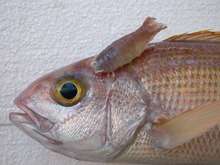Pristipomoides filamentosus
Pristipomoides filamentosus, commonly known as the crimson jobfish, crimson snapper, opakapaka,[2] or Hawaiian pink snapper, is a species of snapper native to the Indian Ocean and into the Pacific Ocean as far east as Hawaii and Tahiti. They inhabit waters over rocky substrates at depths from 40 to 400 m (130 to 1,310 ft) seemingly preferring to remain between 180 and 270 m (590 and 890 ft). This species can reach a length of 100 cm (39 in), though most are around 50 cm (20 in). The greatest known weight for this species is 8.2 kg (18 lb). This species is very important to local commercial fisheries and is sought out as a game fish.[3] One of the Deep Seven species of Hawai'i.
| Crimson jobfish | |
|---|---|
| Crimson jobfish | |
| Scientific classification | |
| Kingdom: | |
| Phylum: | |
| Class: | |
| Order: | |
| Family: | |
| Genus: | |
| Species: | P. filamentosus |
| Binomial name | |
| Pristipomoides filamentosus | |
| Synonyms | |
| |

Known parasites of the crimson jobfish include the cymothoid isopod Anilocra gigantea,[4], the pennellid copepod Lernaeolophus sultanus and the nematodes Cucullanus bourdini [5] and Raphidascaris (Ichthyosaurus) eteligis. [6]
According to the FAO, the fish have been overexploited, but are in a recovering state. The commercial capture of crimson jobfish sharply dropped to 4,400 tonnes in 2009 from 25,300 tonnes the previous year.[7]
References
- Russell, B., Lawrence, A., Myers, R., Carpenter, K.E. & Smith-Vaniz, W.F. 2016. Pristipomoides filamentosus. The IUCN Red List of Threatened Species 2016: e.T194331A2312944. https://dx.doi.org/10.2305/IUCN.UK.2016-3.RLTS.T194331A2312944.en. Downloaded on 20 July 2020.
- Tennison, Patricia. "IF YOU CAN SAY OPAKAPAKA, YOU'LL GET HAWAIIAN FISH". chicagotribune.com.
- Froese, Rainer and Pauly, Daniel, eds. (2013). "Pristipomoides filamentosus" in FishBase. December 2013 version.
- Justine, JL.; Beveridge, I.; Boxshall, GA.; Bray, RA.; Miller, TL.; Moravec, F.; Trilles, JP.; Whittington, ID. (2012). "An annotated list of fish parasites (Isopoda, Copepoda, Monogenea, Digenea, Cestoda, Nematoda) collected from Snappers and Bream (Lutjanidae, Nemipteridae, Caesionidae) in New Caledonia confirms high parasite biodiversity on coral reef fish". Aquat Biosyst. 8 (1): 22. doi:10.1186/2046-9063-8-22. PMC 3507714. PMID 22947621.
- Moravec, František; Justine, Jean-Lou (2011). "Cucullanid nematodes (Nematoda: Cucullanidae) from deep-sea marine fishes off New Caledonia, including Dichelyne etelidis n. sp". Systematic Parasitology. 78 (2): 95–108. doi:10.1007/s11230-010-9281-8. ISSN 0165-5752. PMID 21279559.
- Moravec, František; Justine, Jean-Lou (2012). "Raphidascaris (Ichthyascaris) etelidis n. sp. (Nematoda, Anisakidae), a new ascaridoid nematode from lutjanid fishes off New Caledonia". Zoosystema. 34 (1): 113–121. doi:10.5252/z2012n1a4. ISSN 1280-9551.
- FIRMS Reports (2009) Crimson jobfish - Seychelles (Mahe Plateau) In: Fishery Resources Monitoring System (FIRMS): Status of stocks and resources 2010. FAO, Rome.
